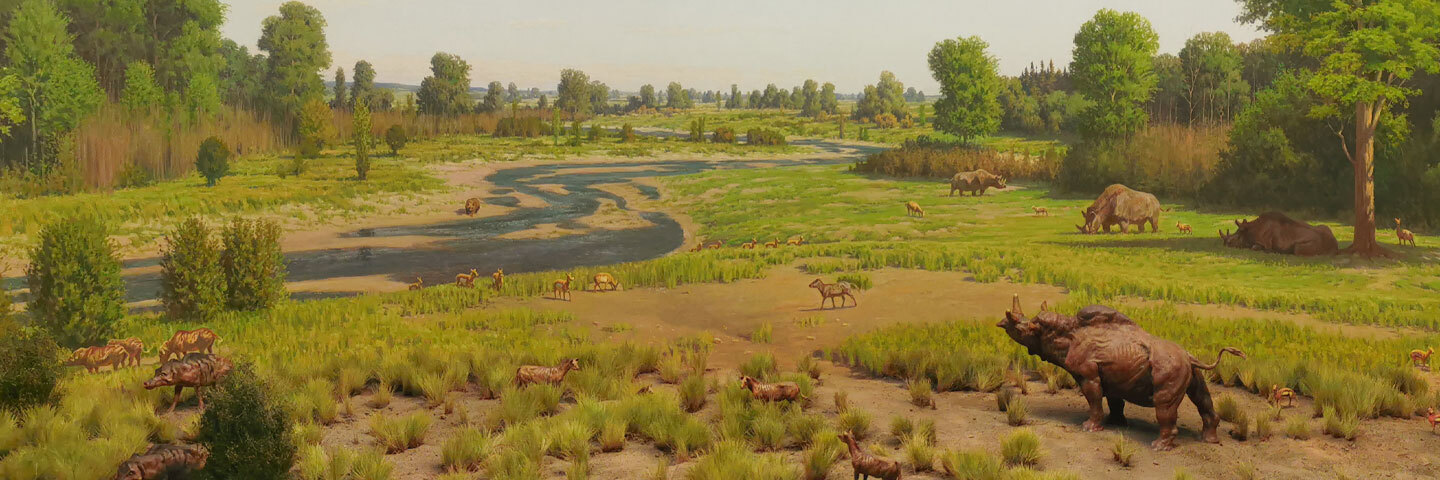Giant Reptiles and Dinosaurs
Our Earth Science Gallery describes Saskatchewan's fascinating ancient history and geological resources -- from how the formation of the Earth provided Saskatchewan with rich mineral resources, to giant reptiles, dinosaurs and other extinct creatures that have lived in Saskatchewan during the past two billion years.

Meet the Mosasaur
Among these reptiles was the mosasaur, a close relative of the lizards, which had a flattened tail for propelling itself through the water, and flippers for steering. Its body was streamlined, and it was probably quick and agile in the water, catching fish in its powerful jaws. Saskatchewan's mosasaurs were nothing to sneeze at; fossils found in areas between Saskatchewan Landing Provincial Park and Riverhurst tell us that they were up to 10 m in length! This exhibit illustrates what a full-size mosasaur might have looked like, lunging toward its prey.

Last Days of the Dinosaurs
Saskatchewan’s fossil record shows that the province was home to both carnivorous and herbivorous dinosaurs, including meat-eaters like Tyrannosaurus rex, horned dinosaurs like Triceratops, and duck-billed dinosaurs such as Edmontosaurus. When the Cretaceous Period came to an end, the dinosaurs, pterosaurs, mosasaurs and plesiosaurs, as well as a great variety of other species including micro-organisms and ammonoids, had all become extinct.
Many scientists believe that this mass extinction was caused by an asteroid (about 10 km in diameter) that collided with the Earth's surface. The impact would have created enough dust to spread around the globe, acting as a barrier to sunlight. Plants would have died off quickly, which in turn may have caused an ecological disaster. There is considerable evidence for this theory; scientists discovered a layer of iridium, a rare earth element associated with extraterrestrial objects, which coincided with the end of the Cretaceous. Contrary to this idea, there is also evidence suggesting that the extinctions happened much more slowly, caused by gradual shifts in climate and in plant and animal communities. Whatever the cause, the face of the planet was changed forever.
After the Dinosaurs
Saskatchewan has the most complete Tertiary Period fossil record in Canada. The coal deposits left behind by the swamps in southern Saskatchewan contain a great deal about the species that roamed the land after the great Cretaceous extinction. Fish, crocodiles, turtles, salamanders, lizards and a variety of mammals were among the survivors. The fossils show that mammals diversified very quickly at about the time of the demise of the dinosaurs.
Late Eocene: The Great Plains Take Shape
The prairies started to experience seasons as the climate cooled, causing the dense semi-tropical forests to change into large open plains with patches of woodland. Mammals were evolving too. Rhinoceros-like brontotheres, three-toed horses roughly the size of large dogs, small deer-like grazers and even sabre-toothed cats .
Miocene: Life on the Grassy Savannah
The largest numbers of small mammal fossils are of pocket mice, which prefer to live in an open grassy environment. There had to be some sparse forest as well, fossilized wood was found there as were fossils of animals that require trees for food and habitat, like flying squirrels and hedgehogs. Although mastodonts were common during the Miocene, the most numerous large mammals were the three-toed horse Merychippus and the pronghorn, Merycodus.

Buried by Ice: The Advance and Retreat of the Glaciers
Five great sheets of ice covered most of the province. The Wood Mountain region and the Cypress Hills in southwest Saskatchewan were both tall enough not to be covered by the ice sheets.
Nearly all of the landforms that we see in Saskatchewan were shaped by the advance and retreat of the last glaciation. Scientists are unsure what caused the cooling effect that brought about the Ice Age, but they do know how the ice sheets were formed. Thick layers of snow that fell in winter did not completely melt in the summer because of the cooler temperatures, causing a layer of ice to form that became thicker and larger as the years passed.



